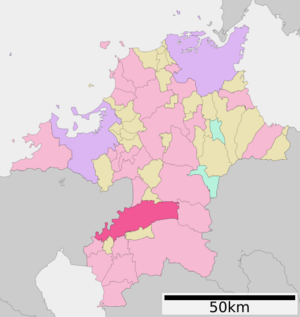Kurume facts for kids
Quick facts for kids
Kurume
久留米市
|
|||||||||||
|---|---|---|---|---|---|---|---|---|---|---|---|

From the upper left:
Nishitetsu Kurume Station, city hall, Suitengu shrine, Kora-taisha shrine, Narita-san temple Ishibashi bunka center, JR Kurume Station |
|||||||||||
|
|||||||||||
 |
|||||||||||
| Country | Japan | ||||||||||
| Region | Kyushu | ||||||||||
| Prefecture | Fukuoka | ||||||||||
| Area | |||||||||||
| • Total | 229.96 km2 (88.79 sq mi) | ||||||||||
| Population
(February 1, 2024)
|
|||||||||||
| • Total | 295,367 | ||||||||||
| • Density | 1,284.428/km2 (3,326.65/sq mi) | ||||||||||
| Time zone | UTC+09:00 (JST) | ||||||||||
| City hall address | 15-3 Jonan, Kurume-shi, Fukuoka-ken 830-8520 | ||||||||||
| Climate | Cfa | ||||||||||
|
|||||||||||
Kurume (久留米市 (Kurume-shi)) is a city in Fukuoka Prefecture, Japan. As of February 1, 2024, about 295,367 people live there in 137,140 homes. The city covers an area of 229.96 square kilometers. This means there are about 1309 people living in each square kilometer.
Contents
Exploring Kurume's Geography
Kurume is located in the southern part of Fukuoka Prefecture. It sits on the Chikugo Plain. The city center is about 40 kilometers from Fukuoka City, the capital of the prefecture.
Kurume is quite long from east to west. The Chikugo River flows through the city from northeast to southwest. This river forms much of the city's boundary. In the southern and southeastern parts of Kurume, you'll find the Minou Mountain Range. This range includes mountains like Mt. Takatori and Mt. Mino.
Cities and Towns Nearby
Kurume shares borders with several other cities and towns.
- In Fukuoka Prefecture:
* Yame * Asakura * Ukiha * Ōkawa * Chikugo * Ogōri * Ōki * Hirokawa * Tachiarai
- In Saga Prefecture:
Kurume's Climate
Kurume has a humid subtropical climate. This means it has hot, humid summers and mild winters. The average temperature each year is about 16.8°C. July is the wettest month, with lots of rain. August is usually the hottest month, averaging around 28.2°C. January is the coldest, with an average of 5.6°C.
The highest temperature ever recorded in Kurume was 39.5°C on August 13, 2018. The coldest was -6.5°C on January 25, 2016.
| Climate data for Kurume (1991−2020 normals, extremes 1977−present) | |||||||||||||
|---|---|---|---|---|---|---|---|---|---|---|---|---|---|
| Month | Jan | Feb | Mar | Apr | May | Jun | Jul | Aug | Sep | Oct | Nov | Dec | Year |
| Record high °C (°F) | 20.0 (68.0) |
23.0 (73.4) |
25.1 (77.2) |
30.7 (87.3) |
35.8 (96.4) |
37.5 (99.5) |
38.5 (101.3) |
39.5 (103.1) |
37.9 (100.2) |
33.2 (91.8) |
27.1 (80.8) |
23.9 (75.0) |
39.5 (103.1) |
| Mean daily maximum °C (°F) | 10.1 (50.2) |
11.8 (53.2) |
15.4 (59.7) |
21.0 (69.8) |
25.9 (78.6) |
28.2 (82.8) |
31.8 (89.2) |
33.1 (91.6) |
29.3 (84.7) |
24.2 (75.6) |
18.1 (64.6) |
12.3 (54.1) |
21.8 (71.2) |
| Daily mean °C (°F) | 5.6 (42.1) |
6.9 (44.4) |
10.2 (50.4) |
15.2 (59.4) |
20.0 (68.0) |
23.5 (74.3) |
27.3 (81.1) |
28.2 (82.8) |
24.5 (76.1) |
19.1 (66.4) |
13.2 (55.8) |
7.7 (45.9) |
16.8 (62.2) |
| Mean daily minimum °C (°F) | 1.7 (35.1) |
2.5 (36.5) |
5.5 (41.9) |
10.1 (50.2) |
15.1 (59.2) |
19.8 (67.6) |
24.0 (75.2) |
24.6 (76.3) |
20.9 (69.6) |
14.8 (58.6) |
8.9 (48.0) |
3.6 (38.5) |
12.6 (54.7) |
| Record low °C (°F) | −6.5 (20.3) |
−6.1 (21.0) |
−4.9 (23.2) |
−0.3 (31.5) |
5.9 (42.6) |
10.8 (51.4) |
16.8 (62.2) |
17.9 (64.2) |
9.9 (49.8) |
3.7 (38.7) |
−0.8 (30.6) |
−3.9 (25.0) |
−6.5 (20.3) |
| Average precipitation mm (inches) | 56.0 (2.20) |
80.2 (3.16) |
122.5 (4.82) |
156.0 (6.14) |
177.7 (7.00) |
339.2 (13.35) |
376.3 (14.81) |
227.7 (8.96) |
165.4 (6.51) |
89.1 (3.51) |
89.3 (3.52) |
59.0 (2.32) |
1,938.4 (76.31) |
| Average precipitation days (≥ 1.0 mm) | 8.3 | 9.0 | 10.6 | 9.9 | 9.4 | 13.2 | 12.6 | 10.7 | 9.0 | 6.2 | 8.3 | 7.8 | 115 |
| Mean monthly sunshine hours | 125.6 | 138.6 | 170.0 | 186.6 | 191.9 | 125.3 | 173.6 | 204.6 | 178.4 | 185.2 | 147.9 | 131.3 | 1,963.9 |
| Source: Japan Meteorological Agency | |||||||||||||
Population Changes Over Time
The population of Kurume has grown over the years. In 2020, the city had 303,316 people. Japan has been keeping track of Kurume's population since 1960.
| Historical population | ||
|---|---|---|
| Year | Pop. | ±% |
| 1960 | 248,997 | — |
| 1965 | 248,963 | −0.0% |
| 1970 | 255,203 | +2.5% |
| 1975 | 265,132 | +3.9% |
| 1980 | 280,291 | +5.7% |
| 1985 | 288,574 | +3.0% |
| 1990 | 294,665 | +2.1% |
| 1995 | 302,741 | +2.7% |
| 2000 | 304,884 | +0.7% |
| 2005 | 306,434 | +0.5% |
| 2010 | 302,323 | −1.3% |
| 2015 | 304,552 | +0.7% |
| 2020 | 303,316 | −0.4% |
| Kurume population statistics | ||
Kurume's Past: A Brief History
The area where Kurume is located was once part of an old Japanese province called Chikugo Province. It was an important center in ancient times. During the Edo Period, a powerful family called the Arima clan ruled the area. They built Kurume Castle and helped the town grow into a busy trading place. They also encouraged local industries.
The city of Kurume was officially created on May 1, 1889.
After World War I (from 1915 to 1919), over 1,000 German and about 50 Austro-Hungarian soldiers were held in a camp in Kurume. This was the largest camp of its kind in Japan. These prisoners were treated well, following international rules. They were allowed to do sports, music, and theater. This friendly exchange between the prisoners and local Japanese people had a lasting effect on Kurume's culture and industries. The prisoners' skills even helped the local rubber industry grow. This industry later became the famous tire company, Bridgestone.
Kurume was also a military town for the Imperial Japanese Army. From 1922, it became a center for rubber and chemical industries. During World War II, Kurume was bombed, which caused damage and sadly, many lives were lost.
Over the years, Kurume grew by joining with nearby villages and towns. In 2001, it became a "special city," and in 2008, it became a "core city." This means it has more local powers and responsibilities. On February 5, 2005, several towns merged into Kurume, making the city even larger.
Kurume's Economy and Products
Kurume is an important business hub in its region. It's famous as the birthplace of Bridgestone, a world-renowned tire company. Many factories that make rubber products are located here. Recently, car parts factories have also moved to Kurume, helping the automobile industry grow in northern Kyushu.
Special Local Products
Kurume has some unique traditional products:
- Kasuri ((絣)): This is a special indigo-dyed cloth with woven patterns.
- Tonkotsu Ramen ((豚骨ラーメン)): A delicious type of ramen with a rich pork-bone broth.
- Rantai Shikki ((籃胎漆器)): Trays and bowls made from lacquered bamboo.
Learning in Kurume: Education
Kurume is home to several universities and many schools.
Universities in Kurume
- Kurume University
- Kurume Institute of Technology
- St.Mary's College
- Kurume Shin-Ai Women's College
Schools for Younger Students
The city has 45 public elementary schools and 17 public junior high schools. There are also two high schools run by the city government and six public high schools run by the Fukuoka Prefecture. In addition, Kurume has one private elementary/junior high school and four private high schools. There are also schools for students with special needs.
Getting Around Kurume: Transportation
Kurume has a good transportation network, including trains and highways.
Train Lines
![]() JR Kyushu - Kyushu Shinkansen (Bullet Train)
JR Kyushu - Kyushu Shinkansen (Bullet Train)
- Kurume
![]() JR Kyushu - Kagoshima Main Line
JR Kyushu - Kagoshima Main Line
- Kurume - Araki
- Kurume - Kurume-Kōkōmae - Minami-Kurume - Kurume-Daigakumae - Mii - Zendōji - Chikugo-Kusano - Tanushimaru
- Miyanojin - Kushiwara - Nishitetsu Kurume - Hanabatake - Shikenjōmae - Tsubuku - Yasutake - Daizenji - Mizuma - Inuzuka
- Miyanojin - Gorōmaru - Gakkōmae - Koganchaya - Kitano - Ōki - Kaneshima
Major Highways
 Kyushu Expressway
Kyushu Expressway National Route 3
National Route 3 National Route 209
National Route 209 National Route 210
National Route 210 National Route 264
National Route 264 National Route 322
National Route 322 National Route 385
National Route 385
Friendly Connections: Sister Cities
Kurume has special "sister city" relationships with other cities around the world. These connections help promote cultural exchange and friendship.
 Kōriyama, Fukushima, Japan
Kōriyama, Fukushima, Japan Modesto, California, United States
Modesto, California, United States Hefei, Anhui, China
Hefei, Anhui, China
Places to Visit in Kurume
Kurume offers many interesting places to explore, from historical sites to beautiful temples.
- Kurume Castle
- Kōra taisha, an important shrine in Chikugo Province
- Zendō-ji, a main Buddhist temple in Kyushu
- Bairin-ji, another important Zen Buddhist temple
- Kurume Suitengū
- Naritasan Kurume Bunin
Important Historical Sites
Kurume is home to several National Historic Sites that protect important parts of Japan's past.
- Ankokuji Burial Jar Cluster
- Urayama Kofun
- Shimobaba Kofun
- Ontsuka - Gongenzuka Kofun
- Takayama Hikokurō Grave
- Kōra-san Kōgoishi
- Chikugo Kokufu ruins
- Tanushimaru Kofun Cluster
- Nichirinji Kofun
- Kurume Domain Arima Clan Cemetery
Famous People from Kurume
Many talented people were born or grew up in Kurume. Here are a few:
- Tanaka Hisashige (1799-1881): An engineer and inventor who started the company that later became Toshiba.
- Hiroshi Yoshida (1876–1950): A famous Japanese painter and woodblock printmaker.
- Shōjirō Ishibashi (1889–1976): The founder of Bridgestone Corporation. His company started in Kurume by making rubber-soled shoes for farmers.
- Leiji Matsumoto (1938–2023): A well-known manga artist and animator, famous for creating many popular anime characters.
- Seiko Matsuda (1962–present): A popular singer and actress.
- Fumiya Fujii (1962–present): The lead singer of the band The Checkers (Japanese band).
- Rena Tanaka (1980–present): An actress.
- Leo Ieiri (1994–present): A singer and songwriter.
Images for kids
See also
 In Spanish: Kurume para niños
In Spanish: Kurume para niños





